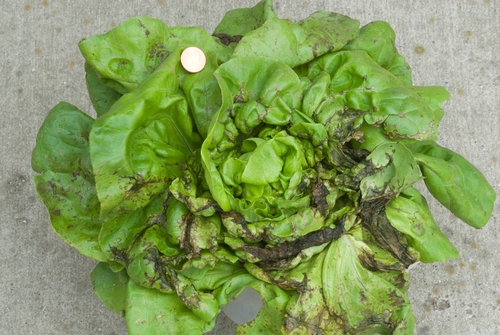As the coastal California lettuce crop heads into the ending fall season and as the inland county region initiates its fall lettuce cycle, both crops are being affected by Tomato spotted wilt virus (TSWV). Diseased plants have leaves with irregularly shaped, brown to dark brown lesions and dead (necrotic) areas (Photo 1); this necrotic tissue can resemble burn damage caused by pesticide or fertilizer applications. Chlorosis (yellowing) can also be observed. Depending on the age of the plant when first infected, these necrotic and chlorotic symptoms can occur on both the older, outer foliage as well as the younger, inner leaves. If plants are affected with TSWV early in their development, growth may be severely stunted. The virus is vectored by thrips and in California is primarily spread by the western flower thrips (Frankliniella occidentalis) (Photo 2).
All lettuce types are susceptible, and TSWV has been identified in iceberg, butterhead, romaine, and leaf lettuces. TSWV has an extremely wide host range that includes over 500 crop and weed species. Vegetable crop hosts include basil, bean, celery, cucumber, eggplant, endive, escarole, fava bean, lettuce, pea, pepper, potato, radicchio, spinach, and tomato. This host range may explain, in part, why TSWV has been observed in a number of lettuce fields in the San Joaquin Valley. The relatively cool summer temperatures have resulted in delayed tomato harvests, causing an overlap of the summer tomato and fall lettuce crops. Thrips vectoring TSWV are therefore able to readily move from the late tomato plantings and into the lettuce fields. (For related information see research conducted by the Gilbertson team (UC Davis) and sponsored by the California Processing Tomato group.)
Growers and pest control advisors should exercise caution if attempting to identify TSWV in the field and without testing. In the coastal region, symptoms caused by the very closely related, thrips-vectored Impatiens necrotic spot virus (INSV) are identical to those caused by TSWV. Romaine and leaf lettuces are susceptible to the lettuce dieback virus complex (Lettuce necrotic stunt virus [LNSV] and Tomato bushy stunt virus [TBSV]) which is also common on the coast.

Photo 1: Tomato spotted wilt virus (TSWV) on lettuce.

Photo 2: Western flower thrips, vector of TSWV.